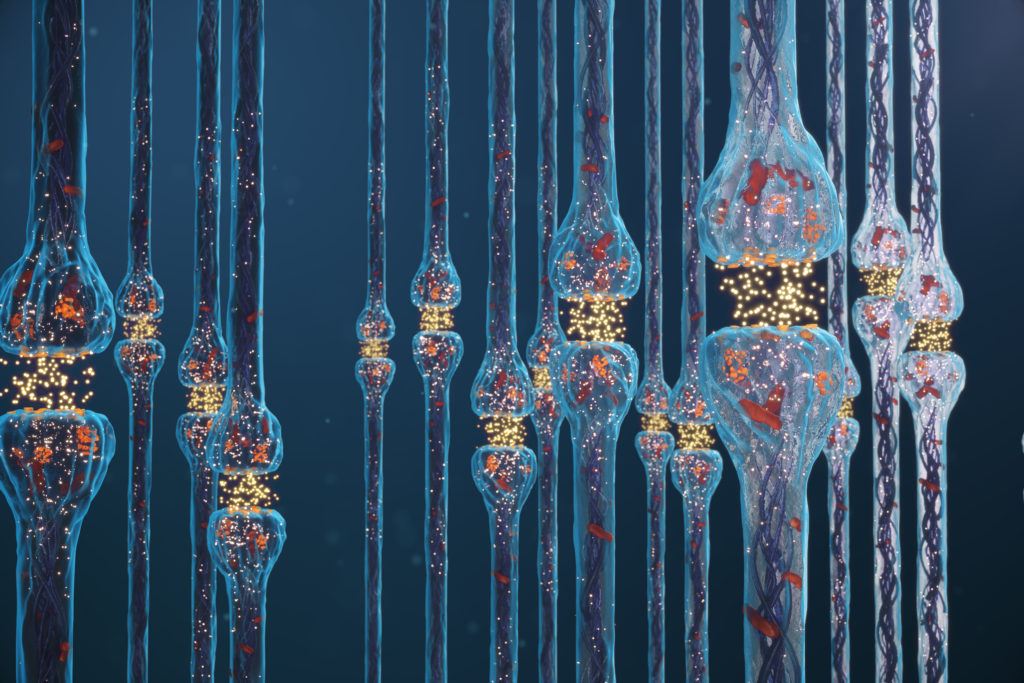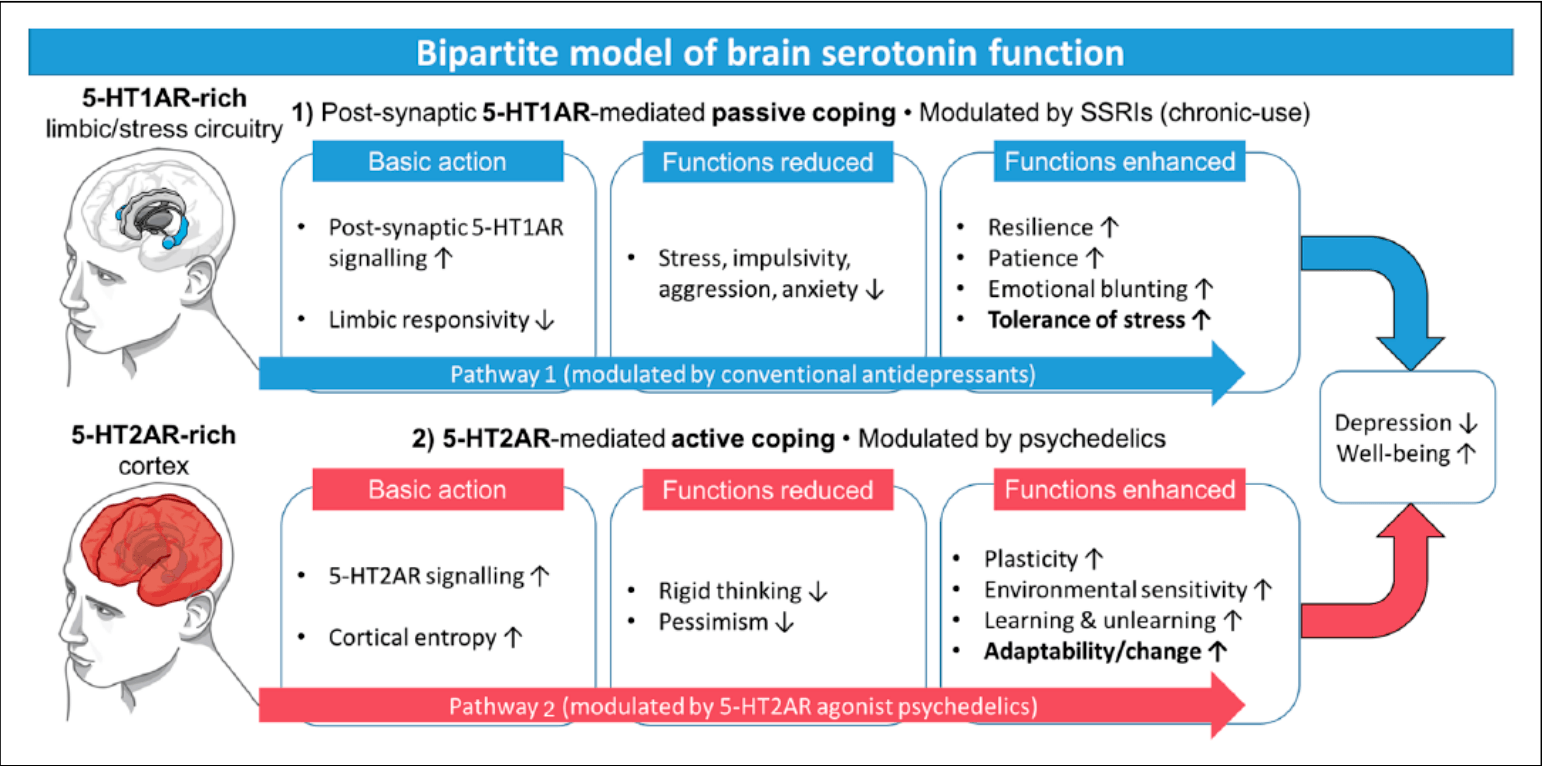
As the antidepressant effects of serotonin (5-HT) agonists and antagonists become more widely researched, the roles of different 5-HT receptor subtypes are becoming more distinguished. Serotonin has a rich neurochemistry with 14 identified receptor subtypes.1 This article focuses on two primary subtypes, 5-HT1AR and 5-HT2AR, and their roles in brain functioning. Distinguishing the two is particularly important in understanding how psychedelics (LSD, 2-CB, psilocybin, etc.) differ from classic antidepressants.2
5-HT1AR vs. 5-HT2AR Signaling
SSRIs modulate 5-HT1AR signaling, whereas psychedelics modulate 5-HT2AR signaling.2 The receptor subtype that has been associated most greatly with the antidepressant effects of SSRIs so far is the 5-HT1AR.3 Some antidepressants (e.g., trazodone) even downregulate 5-HT2AR signaling.3 It is important to note that common antipsychotics blockade the 5-HT2AR functioning in order to mitigate symptoms of psychosis.
On the other hand, psychedelics, also known for their antidepressant effects, possess agonist properties at the 5-HT2AR subtype. This receptor subtype is known to be the trigger of the psychedelic experience. In fact, the blockade of the 5-HT2AR receptor diminishes the subjective effects of LSD: experience of unity, blissfulness, and overall positive therapeutic effects, as confirmed by ketanserin studies.4
Despite their differing roles, 5-HT1AR and 5HT2AR signaling are both crucial in the maintenance of healthy brain functioning.
Active vs. Passive Coping
5-HT1AR signaling offers basal control, moderating emotion and anxiety; 5-HT2AR signaling engages more during times of crisis.2 5-HT1A and 2AR signaling are endogenous pathways that drugs like antidepressants and psychedelics can stimulate. Researchers employ the terms “passive” vs. “active” coping to these two serotonin signaling pathways.2,5
The dual model suggests that under passive coping one tolerates but does not “deal with” a source of psychological distress whereas during active coping one actively deals with psychological distress and can even change their relationship to it.2
5-HT1ARs are widely distributed whereas 5-HT2ARs are more common in regions dedicated to higher-level cortical processing–suggesting that 5-HT2ARs are involved in processes that evolved later.2 5-HT1ARs are found most commonly in the limbic system, alluding to their role in stress management. Increases in postsynaptic[1] 5-HT1AR signaling decrease stress and anxiety while increasing patience and tolerance of stress. 5-HT2ARs are found across the cortex and in areas involved in higher-level cortical processing such as the neocortex and somatosensory cortex. Increases in 5-HT2AR signaling decrease rigid thinking, pessimism, and increase neural plasticity, environmental sensitivity, and adaptability. Both pathways ultimately decrease depression while increasing overall well-being.
[1] Localization of receptor subtypes (i.e. postsynaptic or presynaptic) plays a role in the function of signaling.2 SSRIs inhibit serotonin reuptake, causing increased downstream signaling of serotonin at 5-HT1ARs. Psychedelics are agonists of 5-HT2ARs, affecting both presynaptic and postsynaptic receptor signaling.

Figure 1: The two-part model of brain serotonin function.2 This image depicts the two pathways of serotonin function in the brain, illuminating the basic functions of 5-HT1AR-mediated passive coping and 5-HT2AR-mediated active coping, as well as functions reduced and enhanced in correlation.
Emotional Lability and 5-HT2AR Signaling
The potential for psychedelics to induce emotionally labile, or sensitive states, can be a great agent of therapeutic change (and can also lead to neuroplasticity and increased creativity). This is in line with the “entropic” brain hypothesis, suggesting that psychedelics can induce a plastic, malleable brain state.6
It is suggested that the benefits of active coping can be maximized if the support of psychotherapy is added during the emotionally labile state of 5-HT2AR agonism.2 An emotionally labile state can be used to facilitate neuroplasticity and healing under the right therapeutic setting.2,7
Limitations & Takeaway
While many other receptor subtypes also play a large role in antidepressant activity, this article solely discusses two prevailing serotonin receptor subtypes. It is important to highlight the contributions of 5-HT2AR, as it is linked to an active coping model, the psychomimetic effects of psychedelics, and many of the therapeutic outcomes of psychedelic therapy. Thus, 5-HT2AR agonists are a viable avenue for the treatment of depression, despite the incidence of 5-HT1AR antagonists in antidepressants.

very interesting
Not a professional, just a chronically depressed person searching for answers. I have been reluctant to take traditional antidepressants for a variety of reasons, all boiling down to “I don’t know what they will do to me”. Your article was well written, concise, and explained the mechanisms involved in a clear manner. I will rethink my treatment options based on this new (to me) information. Thank you.
Dear Ed, thank you so much for sharing. I am truly happy to hear you found clarity on treatment options from this article.
this article should be taken down because this is dangerous misinformation.
Please state what you find dangerous about the article.
this is hilariously superficial with respect to the reality of science. Sorry. I work with psychopharm/psychedelics in clinical trials. You’re not equipped to really write this sort of article. Appreciate the effort.
If you work in clinical trials, please speak as a scientist/researcher. What are your concerns about the content of the article?
Hi Sharif, I refer to the limitations of the article at the end. Namely, while many other receptor subtypes also play a large role in antidepressant activity, this article solely discusses two prevailing serotonin receptor subtypes. This article also does not claim that the only MOA of psychedelics lies in 5-HT2A receptor activation, rather elucidates its proposed importance in active vs. passive coping. This article is not intended to be a comprehensive overview of the psychopharmacology of psychedelics, but rather explain a bipartite model of serotonin function as proposed in Carhart-Harris et al. as a proposed theory of antidepressants in… Read more »